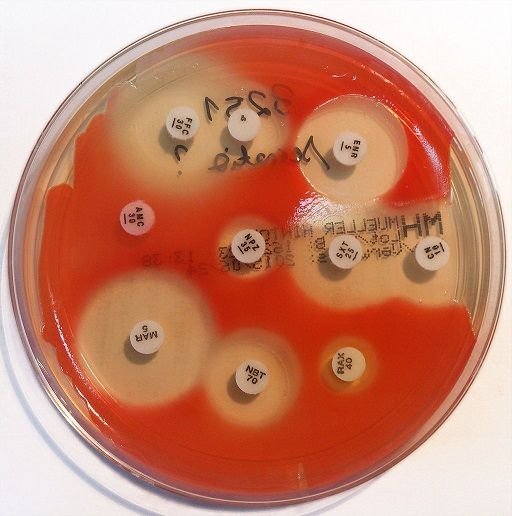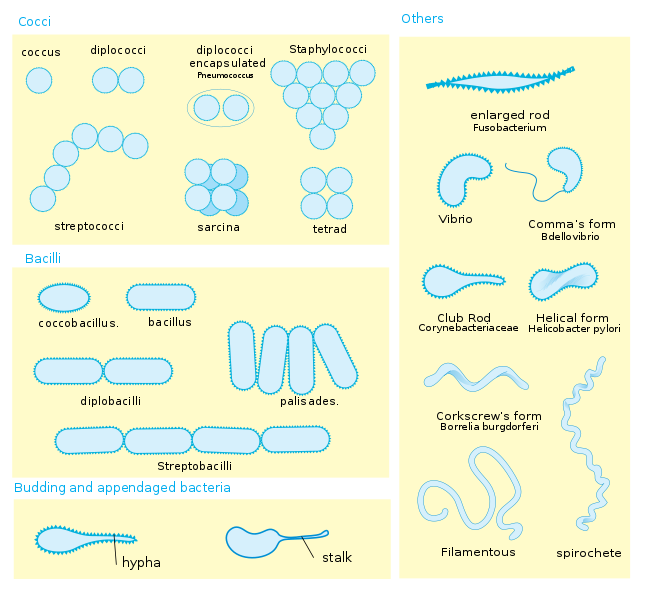What the hell is in my yogurt?! + Basic stuff about bacteria
Space yogurt
So, it all began with hunger. And I decided that I want to eat yogurt.

As I opened the yogurt I was met with something unexpected. A weird pink-orange star-shaped thingie on top of my yogurt (looked kinda nice though). What the?!
Normal person would throw that thing away and open another yogurt. Fortunately, I am not that normal and decided to find out what that slimy alien thing is. And I also opened another yogurt, because I was hungry.

As I was unable to go to school I had to use my old home toy-like microscope. And I did see something, but not in any detail. It is okay for looking at Drosophila melanogaster leg, but something like this was just pure image gibberish. Lots of strange looking dots, thus I was unable to determine what kind of organism that really is. And I am not really used to work with anything else except for yeast (even though contamination is my speciality). Interesting part of my observations was the color of the organism- rust-like orange. Sadly, due to the nature of my “microscope” I am unable to provide magnification details.

I had to implement the most powerful tool available to science. Google. After some time, I was able to find my candidate. Serratia marcescens. It is a gram-negative bacterium as well as human pathogen. The growth temperature of S. marcescens ranges from 5 to 40 °C so it is possible that it could grow in fridge. The colour of the colonies is consistent as well – red/orange. But the thing is, that I did not find any mention of S. marcescens growing on yogurts and diary products. It is usually found in bathrooms, but also dirt and supposedly “sterile” places (whatever that means). I tried finding other possibilities, but without success. I am not sure whether I was right or not and if you know what that thing is let me know.

A bit of explanation
Now, now. Even though the detective part ended many of you may have some unanswered questions. If not, let me give you some. What are bacteria? Are they evil? (muuhahaha) Is there a difference between virus, bacterium or yeast? What does a gram-negative bacterium mean?
Let’s get some answers.
What are bacteria?
Bacteria is the name of large domain of prokaryotic microorganisms. Another question- prokaryotic. Prokaryotic organisms are unicellular organisms that lack any membrane organelles. Organelles?! Well imagine human body with all its organs- lungs, heart, brain and other stuff. Organelles are organs on cellular level. And prokaryotes have just basically different type of organelles than eukaryotic organisms. Eukaryotic organisms – in most basal level organisms that have membrane organelles and can be uni- (baker's yeast), but also multicellular (you). Bacteria can be also differentiated by shapes. They can be spherical (cocci), rod-like (bacilli) or curved-rod-like (vibrio). They can also form different constructs consisting of several cells (see picture bellow). So now when your doctor tells you that the culprit behind your throat infection is streptococcus, you can at least imagine how that little thingie looks like.
Take-home message: Bacteria are prokaryotic microorganisms that come in different shapes and sizes.
Are they evil?
Even though many people express great deal of fear when hearing the word bacteria, it is not true that all of them are pathogenic. In fact, there are about trillion bacterial cells in our bodies and many of these bacteria are beneficial. So, the short answer is no. They are not evil, and you should not clean everything 24/7 because of ominous bacteria. Coz you are full of that stuff. On the other hand, humans should be vigilant and hygienic, because many of the most severe illnesses are due to bacteria (tetanus, cholera, tuberculosis, syphilis, etc.)
Take-home message: Bacteria are not devils small minions, but they also should not be taken lightly.
Is there a difference between virus, bacterium or yeast?
They are all small invisible disease makers, right? Yes aaand no. Of course, they can all be classified as microscopic (unless you let your bacteria or yeast grow) and many of them are pathogenetic, but they are NOT the same. I think that is really good thing to know, mainly in case of diseases caused by these organisms, because people misuse treatments such as antibiotics a lot. If you have flu (viral infection) antibiotics will not get it away. Yeah, they may help to fight some secondary bacterial infection, but that’s it. And why? Because virus and bacterium are fundamentally different. Basic and I mean super-basic differences are here:
Virus – non-cellular microorganism
Bacterium – prokaryotic unicellular microorganism
Yeast – eukaryotic unicellular microorganism
They also differ in size, most of the time the size goes like this: virus < bacteria < yeast. Due to their biological differences they are dealt with using different “weapons”. Some of these differences include replication as well as nucleic acid replication, types of already mentioned organelles, type of cell membrane and cell wall, etc. Will not dig into this, but will cover it for sure in future. I will only dig a little bit into bacterial cell wall. Read on.
What does a gram-negative bacterium mean?
The surface of bacteria consists of cell wall. It is like, hmm, orange peel. Kind of. The surface of bacteria, remember just that. And bacteria are divided into two big groups due to the properties of their cell walls- gram-positive and gram-negative. Why gram? Well, Hans Christian Gram was a Danish bacteriologist that developed special staining technique that could visually differentiate these two types of bacteria. The visual difference is due to the presence of larger amounts of peptidoglycans in cell walls of bacteria. After staining gram-positive bacteria gain violet colour, whereas gram-negative bacteria turn pink. What is this good for? Mainly as diagnostic tool- in relatively short time you can sort out what kind of bacteria are you dealing with. And this fact may prove critical when lives are in danger.
End of the line
So, I am glad if you are reading these lines and were able to finish my first real article. Hopefully this broadened your knowledge about bacteria and demonstrated that even everyday things (like bad yogurt) may ignite spark of curiosity and the desire to learn more.
Thank you for your time, have a nice day!
References##
https://en.wikipedia.org/wiki/Serratia_marcescens
https://en.wikipedia.org/wiki/Bacteria
https://en.wikipedia.org/wiki/Cell_(biology)
https://en.wikipedia.org/wiki/Prokaryote
https://en.wikipedia.org/wiki/Eukaryote
https://en.wikipedia.org/wiki/Gram_stain

will you upvote this post for me please? https://steemit.com/news/@a-a-a/l-a-marzulli-ufo-s-are-real
Welcome to SteemIt!
Thank you! :)